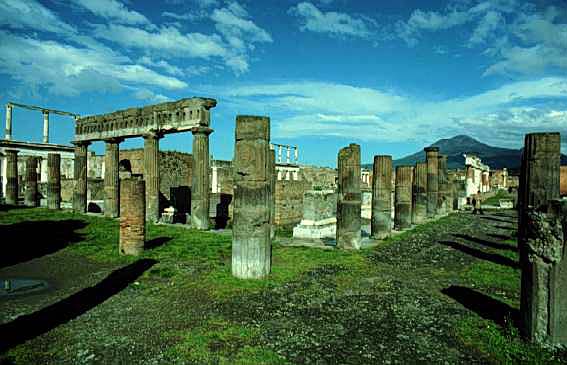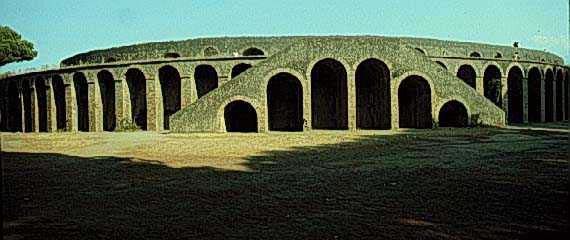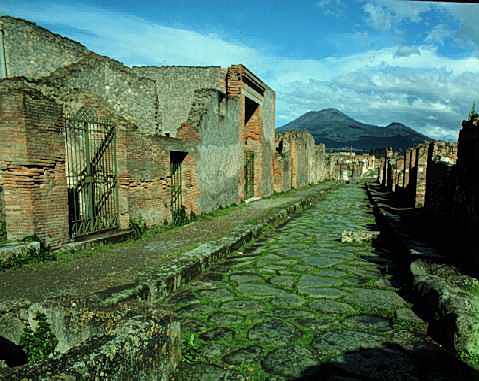|
|
 |
|
Pompeii |
|
written
by Sadie Dobrozsi / 07.04.2004 |
|
|
| |
Site Location |
| |
Pompeii is located in the Bay of Naples in Southern Italy. The city lies in the foothills of Mt. Vesuvius.
|
| |
|
| |
|
| |
Site History |
| |
Pompeii, at one time, was a wealthy town in the Bay of Naples with a population of nearly 20,000 (8,000 slaves, 12,000 free). A wall encircled the town that contained a forum, public and private baths, an amphitheater, and luxurious private residences.
On August 24, 79 A.D., Mt. Vesuvius erupted and threw white hot stones down upon the city. Ash followed quickly - blinding, choking, and burying most of the inhabitants. The ash continued to pile and before long had buried the rooftops of the town, completely covering the remains of Pompeii.
The town remained virtually forgotten until excavations began in the early 1700's. Unfortunately, the initial excavators wanted nothing more than statues and destroyed architectural sites, pillaging walls covered with paintings. It was not until the middle of the century that excavations were coordinated and began to uncover the entirety of the site.
News of the emerging ruins spread quickly through Europe and scholars began to visit Pompeii. The excavations eventually played an important role in the Neoclassical revival as artists, architects, furniture makers, and potters drew inspiration from Pompeii.
|
| |
|
| |
|
| |
Elements of Interest |
| |
| |

|
|
| South view of the forum |
|
| |
|
| |

|
|
| Inside of the baths |
|
| |
|
| |

|
|
| theater and gladiator barracks |
|
| |
|
| |

|
|
| Outside view of the amphitheater |
|
| |
|
* The Forum: The forum was the religious, political, and commercial center of Roman colonies at the time Pompeii was buried. The Temple of Jupiter, the Temple of the Lares, and the Temple of Vespasian are all found in the forum.
* Stabian Baths: The oldest of the public baths and an essential part of daily life, the Stabian baths are located at the Holconius crossroads. These baths, like the others in Pompeii, were located in the busiest and most accessible parts of the city. (A sundial had to be used to regulate the opening times for men and women.) After bathing, patrons were able to enjoy the relaxation offered by perfumers and masseurs who constituted a small portion of the large staff at the baths.
*The Amphitheater: The amphitheater, dating from 75-70 B.C., seated twenty thousand spectators. A strict social hierarchy dictated the seating arrangements at the gladiator games. Venatio duels, fighting between men and lions, between wild and domesticated animals, or between lions and gazelles, often comprised the second half of these games. The games became so popular that part of the theater was converted and used as barracks for the gladiators.
*Temple of Capitolin Jupiter: Worship of the gods was a central part of Pompeian life as is illustrated by this temple (located in the forum). Here Jupiter, Juno, and Minerva are worshipped in support of Roman sovereignty.
|
| |
|
| |
|
| |
Analyze Image |
| |
| |

|
|
| Street of Pompeii |
|
| |
|
This image shows a street in Pompeii with Mt. Vesuvius in the background. The street is somewhat mundane, a necessity in a city as busy as Pompeii. Mt. Vesuvius, looming quietly outside the city walls, seems peaceful and removed, nothing more than scenery. The juxtaposition of innovations of city life with the unpredictable forces of the natural world seem to encompass the story of Pompeii.
|
| |
|
| |
|
| |
Site Questions |
| |
What would the city have become if Mt. Vesuvius had not erupted?
How was this city able to establish such equality between men and women, rich and poor, slaved and free?
|
| |
|
| |
|
|
 |
|
